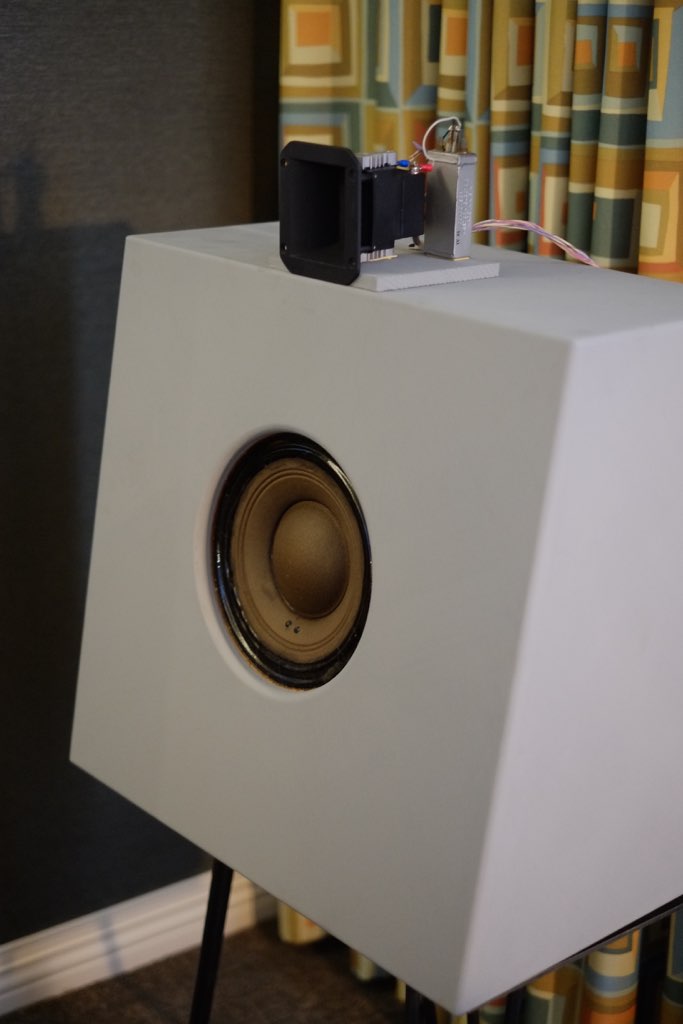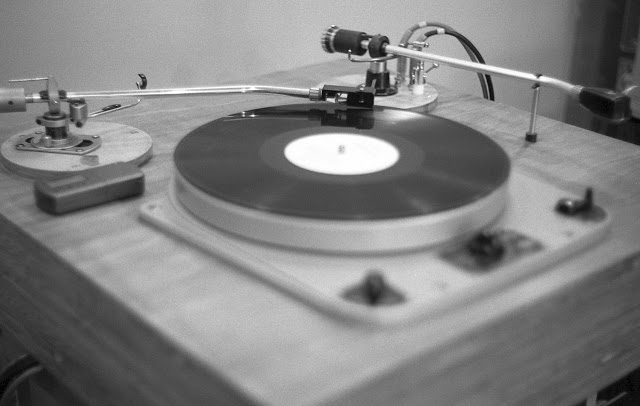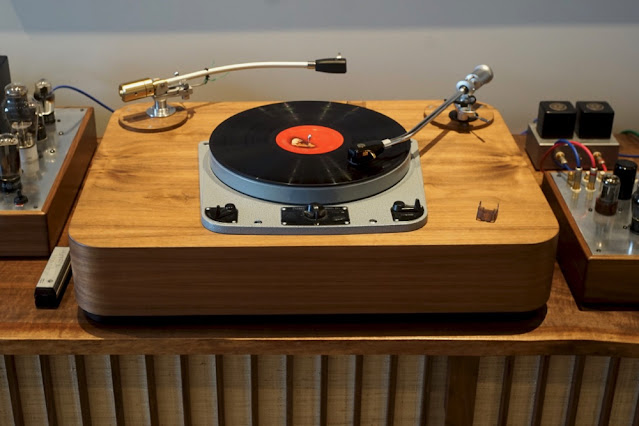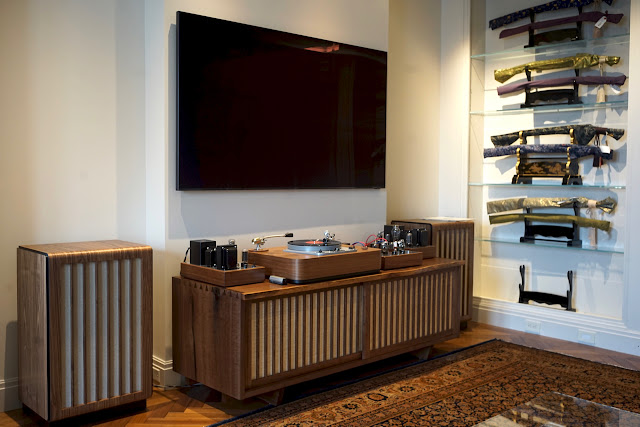The WE756A is the middle child in the Western Electric series of wide range drivers introduced in the late 40s.
I've seen and heard a couple of WE/Altec 728Bs + a dozen or so pairs of 755As, but I've never heard a WE756A and have only seen one in the metal at a radio show many years ago. Although still quite scarce, its Altec 756B brother isn't quite as elusive.
 |
| Back: Blonde + Mahogany Altec Melodist 700A Front L-R : WE728B, Altec 755A/pr. + Altec 756B |
The few Altec 756Bs I've encountered all came out of the Altec Melodist 700A. It's a compact bass reflex speaker system loaded with the 756B, supplemented on top by a 3000A horn tweeter via an N3000B crossover. The 700A belonged to the Melodist monaural hifi system line, which Altec targeted at apartment dwellers in big cities of midcentury America.
Subsequently, the 756B was replaced by an 8" Altec 401A and was re-designated as the Melodist 700B. With the introduction of stereo for the mainstream market in 1958, the Altec Melodist line quietly faded into oblivion.
If found in good condition, the Altec Melodist 700A is a fine looking midcentury modern artifact! Unfortunately, the < 1.5 cf ported box doesn't allow the 756B to shine sonically, IMHO. Since it shares similar proportions to its more successful contemporaries like the Acoustic Research AR-1 and the Jensen Duette, the cabinet design may have been dictated by market positioning rather than sound engineering.
My once-in-a-lifetime lucky find 700A above has lived a hard life. The lower front edge of the cabinet was missing while the sweet and airy but very fragile 3000A horn tweeter element had been replaced by a tiny ferrite magnet dome tweeter.😏 A "mod" that has been circulating in the internet, so watch out.
Fortunately, the 756B is very well preserved. If memory serves me right, the WE756A frame is more substantial than the Altec 756B. That’s probably the reason why the back handles were omitted in the Altec. The 756B has an 8 ohm voice coil, while the WE756A is 4 ohms.
 |
| J-Rob's Altec 756B at Capital Audio Fest 2016 |
Joe Roberts has already done a great job of describing the sonic qualities and proper implementation of the Altec 756B in his (Geekstar) "My big ten inch --Altec 756B" post at the Altec User's Board. He also gave insight on the shifting Asian market for vintage Western Electric and Altec gear. A guaranteed fun and informative read!
Since I don't have Joe's networking skills, I resigned myself to the reality that my Altec 756B will be the main speaker of my monophonic hi-fi set up, just as Altec intended.
 |
| Click for a videoclip |
Meanwhile, I repurposed (sealed) a Heathkit AS10 (almost 2 cf) cabinet to familiarize myself with the 756B. I listened to it as a wide range driver with and without top end assistance from either a 32A/802/34852 + an XO based on this schematic or 3000H with an L-Pad + 0.5 uf - 1 uf paper in oil cap. The simplest XO I used was a 0.22uf paper in oil cap in series with the + terminal of the 3000H, no L-pad needed. That also sounded good, albeit, with slightly less sparkle.
 |
| JE Labs mini 757 inspired by the Western Electric 757A |
After extensive listening in wide range mode, I determined that a mono hifi set up will benefit from a wider baffle + the dispersion pattern of the Western Electric-derived 32 horn. So I sketched a slant front ~ 2.5 cf infinite baffle that has a provision for an Altec 32C horn + 802 driver and sent it to John Piro of Hommage Audio.
 |
| 728B vs. 756B |
As expected, the 756B is more extended at the top end than the 728B with almost, but not quite, equal bass extension. However, music through the 728B held my attention appreciably longer without my reaching for a clip-lead to fill in the top octaves with the 32/802 horn/driver for more harmonic overtones above 5 kHz.
 |
| RTA = Altec 756B in a ~ 2.5 cf infinite baffle |
I confirmed this during one of my shop talks with J-Rob, who also found it more rewarding to listen to 728Bs in wide range mode than to his 756Bs. It makes me wonder if the 756B and its WE756A brother were designed with a middle-child syndrome gene in their sonic DNA.🤔
After many years of collecting Altec 1" compression drivers, I've only landed a single Altec 23744 "light" aluminum diaphragm, which was fitted to an 806 motor that was used in the Altec 9849 monitor speaker.
Things started to crystalize when my friend Dave V. aka Salectric,🙏 sent me his spare .085 mH choke. It was a proprietary part found in the EQ circuit of the Altec 9849 crossover, which is an 8 ohm speaker system. This EQ circuit shapes and boosts the response of the 32/806 horn/driver combo. Incidentally, Dave's "Last PAS" articles written for The Audio Amateur contributed to my 80s Dynaco hacking activities.
 |
| RTA = Altec 32C + 806 + 23744 |
The 4 uf paper in oil capacitor serves as a first order high pass filter hinged around 5 kHz with a gentle 6dB/octave slope, while the variable 8 ohm L-pad shapes and controls upper frequency overtones to taste.
 |
| inside the mini 757 |
John P did a great job of building a very rigid cabinet, which saved me the time and trouble of having to experiment with damping. I just lined the interior panels with Kimpak and I was ready to listen.
 |
| RTA = JE Labs mini 757 |
This project transpired as an opportune moment to assemble all the singleton Altecs from my collection - 756B + 32C + 806 + 23744 - into a formidable monaural hifi speaker system.😊
 |
| JE Labs mini 757 |
My ears hear close to half an octave of bass extension from the mini 757 compared to the 755A in a Silbatone or 618 cabinet. Due to its greater efficiency, it plays louder while dynamics at micro and macro levels are less compressed. The larger cone area of the 756B + wide baffle + 90° horizontal x 60° vertical dispersion of the 32C horn, portray a bigger sense of scale. All of these were achieved without compromising the midrange realism I enjoy from my beloved 755A.
However, the Altec 753C is perceptibly more efficient, offers at least an octave lower of extension with more authority. It also produces higher SPLs.
Alas, we can't defy the physics of sound...
 |
| JE Labs monophonic hifi |
...so I focused on the aesthetics by spicing it up with a touch of Charles Eames and Dieter Rams! 😉















































